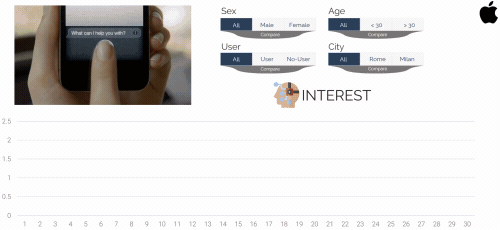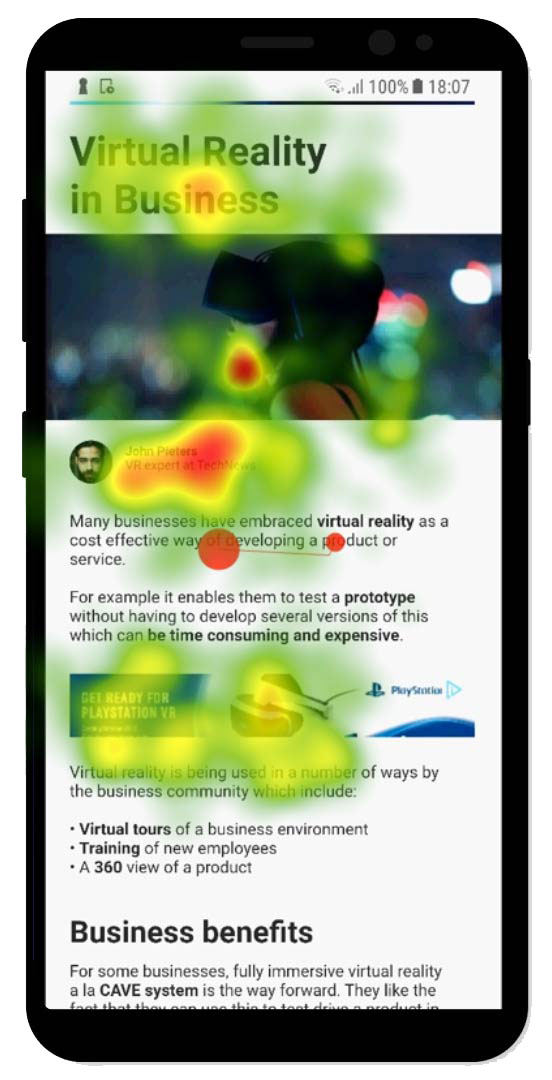Neuromarketing
The application of Neuroscience in Marketing contexts.
Why do we study the brain response of consumers?
About 95% of all thought, emotion, and learning occur in the unconscious mind – that is, without our conscious awareness.
“Professor Gerald Zaltman, Harvard Business School”
The international scientific literature has widely demonstrated the limitations of traditional marketing research methods, such as questionnaires and interviews, in the investigation of the instinctive response of consumers.
15 years of Neuromarketing research and application in business contexts have demonstrated the value of neuroscientific technologies applied to the search for insights associated with the consumer’s emotional and cognitive response.

The figure, courtesy of BrainSigns, above shows the users’ interest when viewing “Apple iPhone 4S Siri” TV commercial. This index, also known as “Approach / Withdrawal index” derives from the analysis of the cerebral activity of the selected sample.
How do companies use Neuromarketing?
Companies use Neuromarketing techniques to explore the brain response of consumers when using products and services, in order to obtain fundamental insights for the development of effective marketing strategies.
The advertising, digital and retail sectors represent relevant contexts for the application of Neuromarketing.
Neuroscientists, psychologists and marketing experts work together in this field in order to help companies to improve their communication strategies, products and services.

The brain response of consumers to specific products, packaging, advertising or other marketing elements can be investigated through neuroimaging techniques such as fMRI (functional magnetic resonance imaging), MEG (Magnetoencephalography), PET (positron emission tomography) and EEG (electroencephalography).
In particular, the EEG is a technique that has great advantages in terms of temporal resolution, as we can become aware of the brain response associated with a stimulus within a few milliseconds. Furthermore, electroencephalography is a non-invasive technique that can be used in real contexts of study, for example during interaction with products in a supermarket.

Not only brain activity. If your goal is that one to explore the attention of consumers, a crucial technology to take into consideration is the Eye Tracker.
The Eye Tracker, through the tracking of eye movements, helps experts to understand the distribution of visual attention generated by a specific product or a creativity of interest.
Through the use of this technique, we can become aware of the number of users who notice specific details of a given product or if your product arouses more attention than another competitor product. The figure showing the users’ gaze and heat maps was kindly provided by BrainSigns.


The intensity of emotions
The ability to evoke an emotional response, through an advertisement, a website or other elements of interest is one of the most important challenges of marketing research. However, the role of emotions in consumer decision-making processes is not easy to explore with traditional research techniques. Emotions are in fact attributable to a non-rational, profound dimension, of which we are often unaware.
A widely used Neuromarketing technique to study the emotional response of consumers is the GSR (Galvanic Skin Response). This technique allows the measurement of the galvanic response of the skin, in particular the changes in the activity of the sweat glands, which are sensitive to the intensity of our emotional state.

The study of the emotional intensity, through the GSR, represents a great opportunity for marketing experts who wish to explore the emotional response of consumers second by second while interacting with specific products, packaging, advertising or other marketing elements.
Would you like to request a Neuromarketing study? Contact me through the BrainSigns Lab, you will receive an answer within 24/48h.
